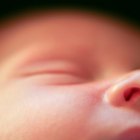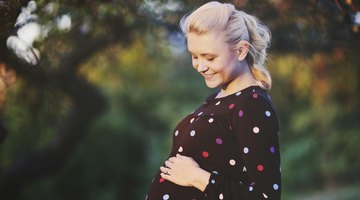How Do Babies Breathe in the Womb?
Breathing involves taking in life-sustaining oxygen when you inhale and releasing the metabolic byproduct carbon dioxide when you exhale.
As amniotic fluid fills the womb, a baby doesn't breathe before birth but instead relies on the mother to obtain oxygen and get rid of excess carbon dioxide. A baby's birth occasions the very first breath — the leadoff event for the many other "firsts" to come.
The Breathing Bypass
Since a baby developing in the womb lacks the ability to breathe, the mother's body must accomplish the exchange of oxygen and carbon dioxide.
In essence, the mother breathes for the baby before birth. Just as an expectant mom is eating for two, she is also breathing for two.
The exchange of gases occurs in the placenta, the organ that develops within the uterus during pregnancy to sustain the developing baby. Although the baby and mother have separate bloodstreams, the placenta serves as an interface where gases as well as nutrients can pass between them.
When an expectant mom inhales and takes in oxygen, her circulatory system delivers some of it to the baby's bloodstream through the placenta and umbilical cord. The baby's circulation rids itself of excess carbon dioxide when it passes into the mother's bloodstream via the placenta. The mother's lungs expel carbon dioxide from both the baby's body and her own when she exhales.
Breathing Practice

Baby Nose Development
Learn More
An unborn baby does not breathe air but practices breathing movements while in the womb. This episodic practice — called fetal breathing movements or FBMs — begins at 8 to 10 weeks of pregancy and continues sporadically until the onset of labor.
FBMs not only serve as pre-birth breathing practice for the baby but also stimulate normal lung growth and development. Early in pregnancy, FBMs consist primarily of chest and abdominal wall movements. As the lungs develop in later pregnancy, FBMs more closely mimic breathing as the baby inhales and exhales amniotic fluid.
Respiratory System Development
The lungs and respiratory system start forming around the 4th week of pregnancy. Lung development continues throughout pregnancy and extends into early childhood.
Two milestone developments must occur for a baby to be capable of breathing outside the womb. The air sacs, or alveoli, must form since they are the site where gas exchange takes place. Additionally, the lungs must produce adequate amounts of a substance called pulmonary surfactant. This slippery liquid makes it easier for the lungs to expand while inhaling and prevents the air sacs from collapsing when exhaling.
Babies born prematurely often require help breathing because their immature lungs are incapable of independent breathing.
This condition called neonatal respiratory distress syndrome (NRDS) typically affects babies born before the 37th week of pregancy. The more premature a baby is, the more likely he is to experience breathing problems after birth.
The First Breath

Brain Motor Skills
Learn More
Upon entering the world outside the womb, a baby faces the task of inflating the lungs while taking its first breath — usually while crying.
Most full-term babies spontaneously take their first breath but some newborns require gentle stimulation. This is particularly common among premature babies.
Babies who cannot breathe independently require respiratory support until they can maintain this life-sustaining function on their own.
Related Articles
- Merck Manual Professional Version: Respiratory Distress Syndrome in Neonates
- Physiology in Childbearing with Anatomy and Related Biosciences; Dorothy Stables and Jean Rankin
- Fetal and Neonatal Lung Development: Clinical Correlates and Technologies for the Future; Alan H. Jobe, Jeffrey A. Whitsett and Steven H. Abman
- Vascular Biology of the Placenta: Placental Blood Circulation
- Perinatology.com: Fetal Development
- Perinatology.com: Biophysical Profile Score (BPS or BPP)










